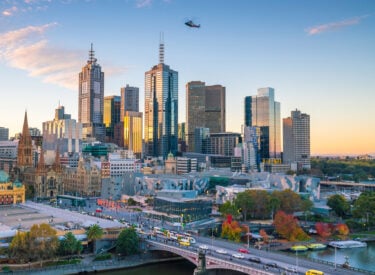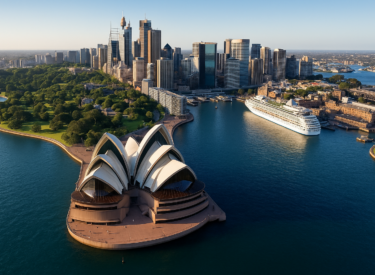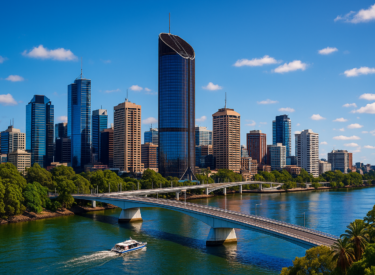According to Corelogic research, Australia’s national median dwelling value delivered a 6.8% annual growth rate over the 30 years to 2022.
Across each of the past three decades, at a macro level, it was the 1992-2002 period that provided the largest capital gains, with CoreLogic’s national Home Value Index (HVI) rising by 77%.
The middle decade (2002-2012) saw the national HVI rise by 59%, while the most recent decade has seen national dwelling values increase by 72%.
This helps to give some kind of indicator about where property prices will head next.Some economists predict a 40-50% growth in Australia's house prices between now and 2030.
This isn’t surprising because it’s often said that over the long term, the average annual growth rate for well-located capital city properties is about 7% (and we know that prices have risen 6.8% per annum over the past 30 years), which would mean, in general, well-located properties should double in value every 7-10 years.
That would put Australia’s median dwelling price at around $1.2 million in 2030.
But, if nothing else, the pandemic years (and the years that followed) have shown us that no matter how many times you forecast property prices, it will always be difficult to predict exactly where property prices will be in three months' time, let alone in 7-10 years into the future.

Note: History shows us that some properties will outperform others by 50-100% in terms of capital growth, so strategic property investors who buy investment-grade properties could expect to see the value of their properties more than double within the next 7-10 years.
After all, that's how averages work - some properties will outperform, and others will underperform.
In other words, we always have to take these house price predictions with a big pinch of salt.
But of course, other investors will manufacture capital growth through renovations or development which is another way to help beat the averages.
Nonetheless, what I do see is that there are emerging trends and shifts in our property market that will serve to hold up prices in the mid-long term.
I’ll talk more about that later.
First, let's dive into predicted house prices for each major city over the next 7 years to the end of 2030.

Predicted house prices in 2030 for Melbourne
As of February 2024, Melbourne’s capital city dwellings averaged $777,250 – with a reported median price of $942,750 for houses and $608,101 for units.
Looking back the Melbourne property market has been one of the strongest and most consistent performers over the last four decades.
Over the last 40 years Melbourne’s median house prices have risen an average of 7.9% per year, and 7.73% for units over the 40-year period.
So, assuming that we can expect the same growth for the remainder of the decade, that could put Melbourne’s house prices as high as around $1.6 million in 2030, and just over $1.1 million for Melbourne units.
Obviously, this past price growth wasn't the same each and every year, as the Melbourne property market worked its way through the typical property cycles, so these figures are a very rough guide only based on historical annual increases.
In fact, Melbourne didn't experience the strong property price growth other capitals enjoyed during the once-in-a-generation boom of 2020-21.
Of course, being the most locked-down city in the world during Covid didn't help.

Note: However, Melbourne’s strong population growth and some large infrastructure spending will underpin Melbourne’s economic growth moving forward.
Victorian residents can look forward to these major infrastructure projects:
- The 15.8 Billion North East Link road project will transform how people move around the city.
- The $11 billion Melbourne Metro Tunnel will allow more than half a million additional people per week to use Melbourne's railway system during peak periods.
- The $10 billion Westgate Tunnel.
- The $10 Billion Melbourne Airport Rail Link is a game-changing public transportation project that, for the first time, connects Melbourne Airport to Victoria's rural and metropolitan train network.
- The M80 Ring Road upgrade ($2,25 billion) and the Monash Freeway Upgrade ($1.37 billion).
- Plus the Monash rail line ($475 million) and Frankston to Baxter rail line ($225 million) upgrades.
Predicted house prices in 2030 for Sydney
As of February 2024, Sydney’s capital city dwellings sit at a median of $1.122 million - that’s a combination of $1.39 million for houses and $828,525 for units.
Given Aussie Home Loans and CoreLogic data shows that Sydney prices grew at an average annual rate of 5.4% in the years between 1990 and 2020, there are high expectations for price increases over the next 7 years.
Analysis of these housing trends suggests that Sydney house prices will average just over $2 million by the end of the decade.
That’s if they continue rising at the same pace as the last 30 years.
Apartment buyers will also notice a sharp increase in prices, with the median unit price expected to rise to around $1.26 million in 2030.
As Australia’s financial capital, Sydney will continue to experience strong population growth.

Note: As more people move to the city, there will be increased demand for housing, and as Sydney is a city of knowledge workers who enjoy higher incomes, demand from this demographic will put upward pressure on house prices.
And these new residents will get the benefit of some major new infrastructure projects including:
- The $12 billion Sydney Metro will feature 31 Metro railways stations.
- The $16 billion WestConnex highway project.
- A $15 billion Pacific Highway upgrade and a $450 million Princes Highway upgrade.
- The $5.3 billion Western Sydney Airport.
- A $2.4 billion Paramatta light rail.
These projects will deliver high-paying jobs and contribute to the growth of Sydney’s economy which will in turn drive further Sydney house price growth.
As the economy continues to grow, people will have more disposable income to invest in buying their homes.
Predicted house prices in 2030 for Brisbane
Today, Brisbane’s median property price sits at $796,818 - or $888,628 for houses and $568,595 for units.
CoreLogic data shows that Brisbane dwelling values increased by 340% (5.1% per annum) over the past 30 years.
So investors may assume that should the average 5.1% per year price increase continue going forward for the next 6-7 years to 2030, median house prices could rise to as high as around $1.3 million by 2030 and units to around $800,000.
As I’ve already mentioned, this is obviously just a rough guide, but Brisbane’s strong population growth and infrastructure spending should underpin long-term property price growth.
The Queensland government has budgeted $37.6 Billion of infrastructure spending in the next 4 years.
Moving forward Greater Brisbane will benefit from a flurry of major infrastructure projects including:
- Cross River Rail ($5.4 billion) is a new 10.2-kilometre rail line between Dutton Park and Bowen Hills, with 5.9 kilometres of twin tunnels beneath the Brisbane River and the CBD
- The Gabba Redevelopment – Value $2.7 billion
- Brisbane Live ($2.5 billion) Located at a key CBD transit hub, a new 18,000-seat entertainment arena complex will be serviced by underground rail and busway infrastructure.
- Queens Wharf
- The Brisbane Metro ($1.244 billion) will be an important part of Brisbane's larger transportation network, which will connect the city to the suburbs.
- The New Queensland Cancer Centre – Value $750 million
Predicted house prices in 2030 for Perth
As of February 1, 2024, Perth’s median dwelling price sits at $676,823 according to CoreLogic data.
The city’s median house price reached $708,335 while units sat at a $475,011 median.

Note: Unlike in Sydney, Melbourne, and Brisbane, property prices in Perth have been relatively flat for most of the past decade.
Now after rising 25.9% over the Covid period, Perth dwelling values now match their July 2022 peak.
And over the past 30 years, CoreLogic data reveals that the city has recorded the nation’s lowest annual growth rate over the period, at 4.8%.
Assuming a 4.8% annual growth rate over the next 7 years, Perth’s house prices could reach around $980,000 and the city’s unit prices as high as around $690,000 by the end of 2030.

Predicted house prices in 2030 for Adelaide
As of February 2024, Adelaide’s median dwelling price sits at $721,376 - $774,969 for houses and $490,313 for units.
According to CoreLogic data, Adelaide housing values increased by 357% over the past 30 years, equating to an average annual compounding growth rate of 5.2%.
Using this figure to project house prices in Adelaide by the end of 2030 would suggest that Adelaide’s house prices could reach up to and even exceed $1.1 million, and just over $700,000 for units.
Key drivers for house prices
As they say…past performance isn’t always the best predictor of the future and clearly, some housing trends will change going forward.
Also, these figures don’t take inflation into account over that time period, but even so, these figures are pretty impressive.
Over the long term, Australian house prices have outperformed the rate of inflation significantly.
Some property pessimists will suggest the last few decades have been particularly good for property and it’s not fair to suggest things will be the same moving forward, especially with the high interest rates and high inflation we’re experiencing at the moment.
However, I would argue that there have been lots of problems and challenges for Australia’s economy and property market over the last 30 years.
Sure Covid was a big surprise, but interestingly their property markets boomed during this pandemic.
But over the last few decades, we have had high interest rates and low interest rates, high inflation and low inflation, governments of both major persuasions, changes to our tax system, overseas wars, and significant challenges to our economy.
In fact, the list goes on and on, but our property markets have remained resilient.
Yet history also showed us that while property values are difficult to predict in the short term, over the long term our strong population growth and the wealth of our nation have pushed up residential property values in Australia.
Another important factor underpinning Australia’s house price resilience is that owner-occupiers dominate - the latest Census shows a homeownership rate of 67%, down from 70% in 2006.
- There are 11.1 million residential dwellings Australia-wide, with a total value of $10.3 trillion.
- These are spread across around 15,000 suburbs.
- An additional 170,000 new dwellings are added every year (this is not enough).
- The total debt against these dwellings is $2.2 trillion, giving an overall Loan to Value Ratio for residential property of around 24%.
- Residential real estate makes up 56.7% of Australian household wealth.
- Investors own around 30% of Australian dwellings.
- There are more than 2.24 million individual property investors in Australia.
- 48% of investors hold 1 investment property, 18.86% hold 2, 5.81% own 3, 2.11% own 4, 0.87% own 5 and 0.89% (or 19,920) of investors hold 6 or more investment properties.
3 trends that will shape our housing markets moving forward
There are 3 important trends which are likely to shape housing markets over the next 6-7 years, and which can help to provide valuable insight into how property prices may be supported into 2030… and beyond.
- Our population is going to grow significantly.
- More jobs are going to be created.
- Wages are going to keep increasing as many knowledge-based jobs will be highly paid.
The latest estimates from the Australian Bureau of Statistics suggest that Australia’s population is expected to increase by 390,000 new people per annum over the next decade and this is 10% higher than the annual increase (excluding the Covid period) than the previous ten years.
Over the next five years, the annual average population across Australia is expected to be 395,000.
So, between now and 2027, Australia’s population is expected to grow by 2.3 million more residents, lifting the total population from 26.6 million to 28.9 million.
| States + territories | Annual growth next 5 years | % share of growth | Population in 2029 | % distribution |
|---|---|---|---|---|
| New South Wales | 117,500 | 30% | 9,046,800 | 31% |
| Victoria | 126,000 | 32% | 7,528,500 | 26% |
| Queensland | 80,700 | 20% | 5,943,500 | 21% |
| South Australia | 18,500 | 5% | 1,968,300 | 7% |
| Western Australia | 37,100 | 9% | 3,071,400 | 11% |
| Tasmania | 4,130 | 1% | 603,400 | 2% |
| Northern Territory | 3,360 | 1% | 275,100 | 1% |
| ACT | 7,610 | 2% | 509,300 | 2% |
| Australia | 394,900 | 100% | 28,946,300 | 100% |
ABS: Medium projections (2022 base). Average annual growth between financial 2024 and 2029.
This means we’ll need to build the equivalent of another Perth – in terms of population size – to accommodate this projected growth in the next 5 years alone.
There will be the need to build some 1.2 million new dwellings – 240,000 each year – over the next five years to accommodate this expected increase in people.
Some 80% of this growth is expected to settle in New South Wales, Victoria and Queensland.
When including Western Australia these four states will likely hold some 90% of the population increase between now and 2030.

How do I outperform the average growth rate?
The system that we use at Metropole, which has helped many clients build substantial portfolios with properties that double in value in less than 10 years, uses what I call our top-down approach (going from the macro to the micro).
This starts with examining the macro factors affecting our property markets and drills down to the micro level.
Here are the 6 steps:
- We start by looking at the big picture (the macroeconomic environment).
- We look for the right state to invest in (one that will outperform the Australian market averages because of its economic growth and population growth).
- We look for the suburbs that will outperform with regard to capital growth (generally gentrifying neighbourhoods with the right demographics).
- We look for the right location within that suburb (investment-grade locations are key here).
- We look for the right property (investment-grade properties within those investment-grade locations).
- The (not cheap) right price.

Tip: Remember: Focus on investment-grade property!
The most important focus for investors is to look for investment-grade property.
‘Cheap’ property will always be ‘cheap’ so don’t get lured into thinking you’re getting a bargain.
Over the next few years, I expect that house prices will grow more than apartment prices, but well-located townhouses on a decent land size will also make excellent investments and are currently in strong demand by many first-home buyers being priced out of the market.
Now that doesn’t mean apartments won’t make good investments, some will.
I see family-friendly apartments in the middle ring suburbs of our capital cities being in strong demand by singles and young couples who want to enjoy the amenities of great locations but can’t afford houses or townhouses.
And the fact that construction costs for new apartments are soaring means that new developments will need to come on the market at significantly higher prices, pulling up the value of established apartments.

Note: No matter how many times you review the data, it's important to remember that it is nearly impossible to predict exactly what house or unit prices will look like in 2030.
After all, the pandemic showed us how quickly things can change.
What we do know is that demographics, immigration levels, population, the wealth of our nation, and housing affordability will continue to be key trends to watch going forward.















